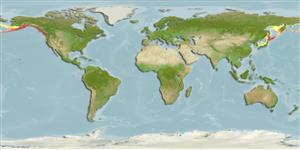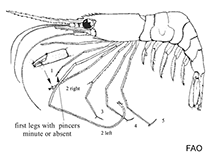Pandalus hypsinotus Brandt, 1851
Coonstriped shrimp| Native range | All suitable habitat | Point map | Year 2050 |

|
| This map was computer-generated and has not yet been reviewed. |
| Pandalus hypsinotus AquaMaps Data sources: GBIF OBIS |
Upload your photos
Google image | No image available for this species;
drawing shows typical species in Pandalidae.
Google image | No image available for this species;
drawing shows typical species in Pandalidae.
Classification / Names Common names | Synonyms | CoL | ITIS | WoRMS
Malacostraca | Decapoda | Pandalidae
Environment: milieu / climate zone / depth range / distribution range Ecology
Benthic; depth range 5 - 501 m (Ref. 8). Temperate, preferred 5°C (Ref. 107945); 63°N - 33°N, 126°E - 122°W
Distribution Countries | FAO areas | Ecosystems | Occurrences | Introductions
Northern Pacific and Northwest Atlantic: From Korea Strait, Japan and West Bering Sea to Kuril Islands, Gulf of Alaska and Puget Sound, Washington, USA.
Length at first maturity / Size / Weight / Age
Maturity: Lm ? range ? - ? cm Max length : 20.9 cm TL male/unsexed; (Ref. 8)
Short description Morphology
Known as "king", "rose", or "hump", it is superficially similar to P. danae except that it is blotched, redder in color and larger. As in P. danae the body is stout and the shell hard, but the surface is smooth and the carapace strongly arched dorsally. There are 17 to 22 dorsal spines which occupy the anterior three fifths of the carapace and extend an equal distance on the rostrum. The distal portion of the rostrum is strongly ascending and unarmed, except at the tip, which is oblique and armed with three immovable spines.
Maximum depth from Ref. 116014.
Life cycle and mating behavior Maturity | Reproduction | Spawning | Eggs | Fecundity | Larvae
Male yearlings (March-May) reach their sexual maturity by fall. Metamorphosis occur in spring and in shallow water (20-30 fathoms) around 2 years of age, females mature few months after (September) where spawning starts. Eggs were found by April (Ref. 82652).
Main reference
References | Coordinator | Collaborators
Williams, A.B., L.G. Abele, D.L. Felder, H.H. Hobbs Jr., R.B. Manning, P.A. McLaughlin and I. Pérez Farfante. 1988. (Ref. 2214)
IUCN Red List Status (Ref. 130435)
CITES status (Ref. 108899)
Not Evaluated
CMS (Ref. 116361)
Not Evaluated
Threat to humans
Human uses
Fisheries: commercial
FAO - Fisheries: landings | FishSource | Sea Around Us
Tools
More information
Internet sources
BHL | BOLD Systems | CISTI | DiscoverLife | FAO(Fisheries: ; publication : search) | Fishipedia | GenBank (genome, nucleotide) | GloBI | Gomexsi | Google Books | Google Scholar | Google | PubMed | Tree of Life | Wikipedia (Go, Search) | Zoological Record
Estimates based on models
Preferred temperature
(Ref. 115969): 0.8 - 8.6, mean 4.3 (based on 501 cells).
Nutrients: Calcium = 109 [35, 184] mg/100g; Iron = 1.59 [1.21, 1.97] mg/100g; Protein = 20.2 [19.2, 21.3] %; Omega3 = 0.285 [0.185, 0.386] g/100g; Selenium = 48.3 [-31.7, 128.3] μg/100g; VitaminA = 0 μg/100g; Zinc = 1.79 [1.17, 2.40] mg/100g (wet weight).



